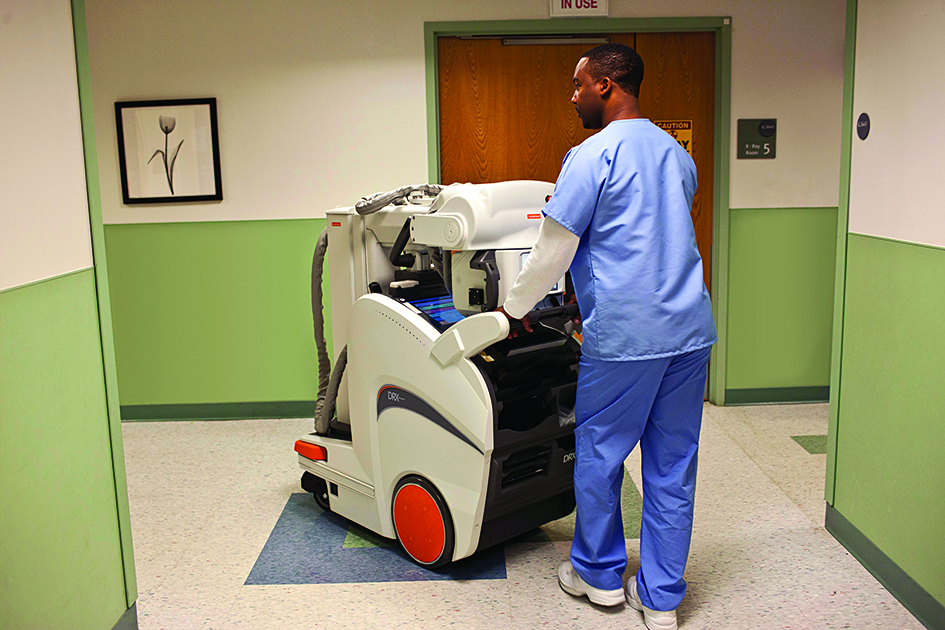Carestream Solutions “Right for Today, Ready for Tomorrow”
|
By MedImaging International staff writers Posted on 25 Mar 2014 |

Image: Carestream’s DRX Revolution Mobile X-ray System (Photo courtesy of Carestream Health).

Image: Cyrill Aschenbrenner is Regional Business Manager Europe for X-ray Solutions at Carestream (Photo courtesy of Carestream).
“Right for Today, Ready for Tomorrow,” say Carestream Health (Rochester, NY, USA), proudly displaying their new strapline at this year’s European Congress of Radiology (ECR). The phrase epitomizes the company’s approach to providing customer solutions that respond to the changing nature of the European medical imaging environment. Carestream’s range of X-ray solutions clearly reflects this.
Cyrill Aschenbrenner, is Regional Business Manager Europe for X-ray Solutions at Carestream. “This is really our solution and approach to every customer, wherever they are on their journey to going digital, whether their investment is under tight budgetary constraints, we have our customers covered for future investments as well as current needs.”
Whenever these requirements change over time, customers can invest over that period rather than in one go and we can meet their needs. “We can upgrade, enhance, and deliver new features,” added Mr. Aschenbrenner.
One example of how the “Right for Today, Ready for Tomorrow” strapline comes into effect is evident with the CARESTREAM DRX-Revolution Mobile X-ray System. “Often in a hospital, the X-ray detector is brought from the mobile unit to the ICU in the morning for an hour or two and then it is parked for the day, resulting in a lot of unused capital in this detector,” he highlighted. “Now we have a solution whereby detectors can be shared between rooms to make workflow easier.”
With the CARESTREAM DRX-Mobile Retrofit Kit, radiology departments can retrofit their analogue mobile systems with the power of DR technology. Furthermore, the wireless DRX Detector enables departments to optimize their workflow and leverage optimal investment in their existing mobile units. The DRX Mobile Retrofit Kit is also compatible with imaging systems from other manufacturers.
While in discussion with Carestream at their ECR stand, a customer from Norway who had bought the mobile detector explained that, their budgetary constraints meant they could not buy as many detectors as they wished, so they opted for the retrofit approach. The customer said, “We found enabling and disabling fast, you can take it straight to the room, expose and there you go.”
If customers wish to change X-ray units later, they can keep the detector if they wish. “This approach to systems upgrades represents our tag-line perfectly. Customers value this because Europe is moving at different speeds and investments are lower than previously so we need to provide solutions over time,” explained Mr Aschenbrenner.
Also at this year’s ECR, Carestream introduced the latest version of image acquisition software for their CR and DR systems. This includes a bone suppression feature, which creates a companion image to suppress the appearance of posterior ribs and clavicles while enhancing the visualization of soft tissue in the chest. A new IHE Dose Reporting capability collects and distributes dose information from all CARESTREAM DR and CR systems to the hospital’s PACS.
“Our new bone suppression feature is designed to increase diagnostic confidence due to improved visibility of lung nodules and other pathology,” said Mr. Aschenbrenner. “Since the companion image is automatically generated from the original chest image, it will be available in seconds and requires no additional exposure to the patient or a separate X-ray exam. This feature will be available for portable and room-based CR and DR systems.”
Related Links:
Carestream Health
Cyrill Aschenbrenner, is Regional Business Manager Europe for X-ray Solutions at Carestream. “This is really our solution and approach to every customer, wherever they are on their journey to going digital, whether their investment is under tight budgetary constraints, we have our customers covered for future investments as well as current needs.”
Whenever these requirements change over time, customers can invest over that period rather than in one go and we can meet their needs. “We can upgrade, enhance, and deliver new features,” added Mr. Aschenbrenner.
One example of how the “Right for Today, Ready for Tomorrow” strapline comes into effect is evident with the CARESTREAM DRX-Revolution Mobile X-ray System. “Often in a hospital, the X-ray detector is brought from the mobile unit to the ICU in the morning for an hour or two and then it is parked for the day, resulting in a lot of unused capital in this detector,” he highlighted. “Now we have a solution whereby detectors can be shared between rooms to make workflow easier.”
With the CARESTREAM DRX-Mobile Retrofit Kit, radiology departments can retrofit their analogue mobile systems with the power of DR technology. Furthermore, the wireless DRX Detector enables departments to optimize their workflow and leverage optimal investment in their existing mobile units. The DRX Mobile Retrofit Kit is also compatible with imaging systems from other manufacturers.
While in discussion with Carestream at their ECR stand, a customer from Norway who had bought the mobile detector explained that, their budgetary constraints meant they could not buy as many detectors as they wished, so they opted for the retrofit approach. The customer said, “We found enabling and disabling fast, you can take it straight to the room, expose and there you go.”
If customers wish to change X-ray units later, they can keep the detector if they wish. “This approach to systems upgrades represents our tag-line perfectly. Customers value this because Europe is moving at different speeds and investments are lower than previously so we need to provide solutions over time,” explained Mr Aschenbrenner.
Also at this year’s ECR, Carestream introduced the latest version of image acquisition software for their CR and DR systems. This includes a bone suppression feature, which creates a companion image to suppress the appearance of posterior ribs and clavicles while enhancing the visualization of soft tissue in the chest. A new IHE Dose Reporting capability collects and distributes dose information from all CARESTREAM DR and CR systems to the hospital’s PACS.
“Our new bone suppression feature is designed to increase diagnostic confidence due to improved visibility of lung nodules and other pathology,” said Mr. Aschenbrenner. “Since the companion image is automatically generated from the original chest image, it will be available in seconds and requires no additional exposure to the patient or a separate X-ray exam. This feature will be available for portable and room-based CR and DR systems.”
Related Links:
Carestream Health
Latest Radiography News
- AI Improves Early Detection of Interval Breast Cancers
- World's Largest Class Single Crystal Diamond Radiation Detector Opens New Possibilities for Diagnostic Imaging
- AI-Powered Imaging Technique Shows Promise in Evaluating Patients for PCI
- Higher Chest X-Ray Usage Catches Lung Cancer Earlier and Improves Survival
- AI-Powered Mammograms Predict Cardiovascular Risk
- Generative AI Model Significantly Reduces Chest X-Ray Reading Time
- AI-Powered Mammography Screening Boosts Cancer Detection in Single-Reader Settings
- Photon Counting Detectors Promise Fast Color X-Ray Images
- AI Can Flag Mammograms for Supplemental MRI
- 3D CT Imaging from Single X-Ray Projection Reduces Radiation Exposure
- AI Method Accurately Predicts Breast Cancer Risk by Analyzing Multiple Mammograms
- Printable Organic X-Ray Sensors Could Transform Treatment for Cancer Patients
- Highly Sensitive, Foldable Detector to Make X-Rays Safer
- Novel Breast Cancer Screening Technology Could Offer Superior Alternative to Mammogram
- Artificial Intelligence Accurately Predicts Breast Cancer Years Before Diagnosis
- AI-Powered Chest X-Ray Detects Pulmonary Nodules Three Years Before Lung Cancer Symptoms
Channels
MRI
view channel
Cutting-Edge MRI Technology to Revolutionize Diagnosis of Common Heart Problem
Aortic stenosis is a common and potentially life-threatening heart condition. It occurs when the aortic valve, which regulates blood flow from the heart to the rest of the body, becomes stiff and narrow.... Read more
New MRI Technique Reveals True Heart Age to Prevent Attacks and Strokes
Heart disease remains one of the leading causes of death worldwide. Individuals with conditions such as diabetes or obesity often experience accelerated aging of their hearts, sometimes by decades.... Read more
AI Tool Predicts Relapse of Pediatric Brain Cancer from Brain MRI Scans
Many pediatric gliomas are treatable with surgery alone, but relapses can be catastrophic. Predicting which patients are at risk for recurrence remains challenging, leading to frequent follow-ups with... Read more
AI Tool Tracks Effectiveness of Multiple Sclerosis Treatments Using Brain MRI Scans
Multiple sclerosis (MS) is a condition in which the immune system attacks the brain and spinal cord, leading to impairments in movement, sensation, and cognition. Magnetic Resonance Imaging (MRI) markers... Read moreUltrasound
view channel.jpeg)
AI-Powered Lung Ultrasound Outperforms Human Experts in Tuberculosis Diagnosis
Despite global declines in tuberculosis (TB) rates in previous years, the incidence of TB rose by 4.6% from 2020 to 2023. Early screening and rapid diagnosis are essential elements of the World Health... Read more
AI Identifies Heart Valve Disease from Common Imaging Test
Tricuspid regurgitation is a condition where the heart's tricuspid valve does not close completely during contraction, leading to backward blood flow, which can result in heart failure. A new artificial... Read moreNuclear Medicine
view channel
Novel Radiolabeled Antibody Improves Diagnosis and Treatment of Solid Tumors
Interleukin-13 receptor α-2 (IL13Rα2) is a cell surface receptor commonly found in solid tumors such as glioblastoma, melanoma, and breast cancer. It is minimally expressed in normal tissues, making it... Read more
Novel PET Imaging Approach Offers Never-Before-Seen View of Neuroinflammation
COX-2, an enzyme that plays a key role in brain inflammation, can be significantly upregulated by inflammatory stimuli and neuroexcitation. Researchers suggest that COX-2 density in the brain could serve... Read moreGeneral/Advanced Imaging
view channel
AI-Based CT Scan Analysis Predicts Early-Stage Kidney Damage Due to Cancer Treatments
Radioligand therapy, a form of targeted nuclear medicine, has recently gained attention for its potential in treating specific types of tumors. However, one of the potential side effects of this therapy... Read more
CT-Based Deep Learning-Driven Tool to Enhance Liver Cancer Diagnosis
Medical imaging, such as computed tomography (CT) scans, plays a crucial role in oncology, offering essential data for cancer detection, treatment planning, and monitoring of response to therapies.... Read moreImaging IT
view channel
New Google Cloud Medical Imaging Suite Makes Imaging Healthcare Data More Accessible
Medical imaging is a critical tool used to diagnose patients, and there are billions of medical images scanned globally each year. Imaging data accounts for about 90% of all healthcare data1 and, until... Read more
Global AI in Medical Diagnostics Market to Be Driven by Demand for Image Recognition in Radiology
The global artificial intelligence (AI) in medical diagnostics market is expanding with early disease detection being one of its key applications and image recognition becoming a compelling consumer proposition... Read moreIndustry News
view channel
GE HealthCare and NVIDIA Collaboration to Reimagine Diagnostic Imaging
GE HealthCare (Chicago, IL, USA) has entered into a collaboration with NVIDIA (Santa Clara, CA, USA), expanding the existing relationship between the two companies to focus on pioneering innovation in... Read more
Patient-Specific 3D-Printed Phantoms Transform CT Imaging
New research has highlighted how anatomically precise, patient-specific 3D-printed phantoms are proving to be scalable, cost-effective, and efficient tools in the development of new CT scan algorithms... Read more
Siemens and Sectra Collaborate on Enhancing Radiology Workflows
Siemens Healthineers (Forchheim, Germany) and Sectra (Linköping, Sweden) have entered into a collaboration aimed at enhancing radiologists' diagnostic capabilities and, in turn, improving patient care... Read more


















